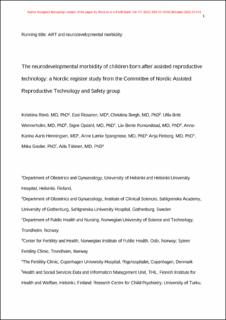| dc.contributor.author | Rönö, Kristiina | |
| dc.contributor.author | Rissanen, Essi | |
| dc.contributor.author | Bergh, Christina | |
| dc.contributor.author | Wennerholm, Ulla-Britt | |
| dc.contributor.author | Opdahl, Signe | |
| dc.contributor.author | Romundstad, Liv Bente Bergem | |
| dc.contributor.author | Henningsen, Anna-Karina Aaris | |
| dc.contributor.author | Spangmose, Anne Lærke | |
| dc.contributor.author | Pinborg, Anja | |
| dc.contributor.author | Gissler, Mika | |
| dc.contributor.author | Tiitinen, Aila | |
| dc.date.accessioned | 2023-08-15T06:37:20Z | |
| dc.date.available | 2023-08-15T06:37:20Z | |
| dc.date.created | 2022-05-02T13:06:10Z | |
| dc.date.issued | 2022 | |
| dc.identifier.citation | Fertility and Sterility. 2022, 117 (5), 1026-1037. | en_US |
| dc.identifier.issn | 0015-0282 | |
| dc.identifier.uri | https://hdl.handle.net/11250/3083960 | |
| dc.description.abstract | Objective
To assess the risk of neurodevelopmental disorders in singletons born after the use of assisted reproductive technology (ART) compared with singletons born without the use of ART.
Design
Nordic register-based study.
Setting
Cross-linked data from Medical Birth Registers and National ART and Patient Registers; liveborn singletons in 1995–2014 in Denmark and Finland, 2005–2015 in Norway, and 1995–2015 in Sweden with follow-up to 2014 (Denmark and Finland) or 2015 (Norway and Sweden).
Patients
A total of 5,076,444 singletons: 116,909 (2.3%) born with and 4,959,535 (97.7%) born without the use of ART (non-ART).
Interventions
In vitro fertilization, intracytoplasmic sperm injection, and fresh and frozen embryo transfer.
Main Outcome Measures
The primary outcomes (International Statistical Classification of Diseases and Related Health Problems, Tenth Revision, codes) were learning and motor functioning disorders (F80–F83), autism spectrum disorder (F84), attention-deficit/hyperactivity disorder and conduct disorders (F90–F92), and tic disorders (F95). Crude hazard ratios (HRs) and adjusted hazard ratios (aHRs) with 95% confidence intervals were calculated.
Results
Singletons in the ART cohort had a higher adjusted risk of learning and motor functioning disorders (HR, 1.01 [0.96–1.07]; aHR, 1.17 [1.11–1.24]) and a tendency toward a higher risk of autism spectrum disorder (HR, 1.12 [1.04–1.21]; aHR, 1.07 [0.98–1.16]) and attention-deficit/hyperactivity disorder and conduct disorders (HR, 0.82 [0.77–0.86]; aHR, 1.17 [0.99–1.12]) but not of tic disorders (HR, 1.21 [1.06–1.38]; aHR, 1.17 [0.96–1.27]). No differences in risk were found between children born after in vitro fertilization and intracytoplasmic sperm injection or after fresh and frozen embryo transfer.
Conclusions
Our findings of only small differences in neurodevelopment between ART and non-ART singletons are reassuring and in line with previous studies. | en_US |
| dc.language.iso | eng | en_US |
| dc.publisher | Elsevier | en_US |
| dc.rights | Attribution-NonCommercial-NoDerivatives 4.0 Internasjonal | * |
| dc.rights.uri | http://creativecommons.org/licenses/by-nc-nd/4.0/deed.no | * |
| dc.title | The neurodevelopmental morbidity of children born after assisted reproductive technology: a Nordic register study from the Committee of Nordic Assisted Reproductive Technology and Safety group | en_US |
| dc.title.alternative | The neurodevelopmental morbidity of children born after assisted reproductive technology: a Nordic register study from the Committee of Nordic Assisted Reproductive Technology and Safety group | en_US |
| dc.type | Peer reviewed | en_US |
| dc.type | Journal article | en_US |
| dc.description.version | acceptedVersion | en_US |
| dc.source.pagenumber | 1026-1037 | en_US |
| dc.source.volume | 117 | en_US |
| dc.source.journal | Fertility and Sterility | en_US |
| dc.source.issue | 5 | en_US |
| dc.identifier.doi | 10.1016/j.fertnstert.2022.01.010 | |
| dc.identifier.cristin | 2020645 | |
| cristin.ispublished | true | |
| cristin.fulltext | postprint | |
| cristin.qualitycode | 2 | |

